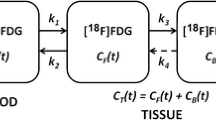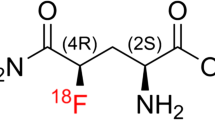Abstract
In order to investigate early changes in the glucose metabolism of irradiated tumours, tumour uptake of 2-[18F]fluoro-2-deoxy-d-glucose (18FDG) was studied in human tumour xenografts. Three human tumour lines [ependymoblastoma (NNE), small cell lung cancer (GLS), and glioblastoma (KYG)] showing different radiosensitivities and incidences of radiation-induced apoptosis were subcutaneously transplanted into nude mice, and were irradiated at a single dose of 10 Gy. Then 0.5 mCi of18FDG was intravenously administered 1 h before sacrifice. The animals were sacrificed at 2, 4 and 6 h following irradiation, and18FDG accumulation in the tumours was examined. Before irradiation, GLS and KYG tumours showed significantly higher rates of18FDG accumulation compared with NNE tumours (P <0.004 andP <0.001, respectively). NNE (the most radiosensitive tumour with the highest incidence of radiation-induced apoptosis), however, displayed a 2.3-fold higher rate of18FDG accumulation at 2 h following irradiation compared with a non-irradiated group (P <0.01), and thereafter showed a plateau up to 6 h. The accumulation did not increase significantly in the other tumours with lower radiosensitivity and much less radiation-induced apoptosis. The rapidity of the increase in18FDG accumulation in the most radiosensitive tumour line, occurring as early as 2 h following irradiation, suggests that the increase was independent of recovery phenomena following radiation damage.
Similar content being viewed by others
References
Iosilevsky G, Front D, Hardoff R, Ben-Arieh Y. Uptake of gallium-67 citrate and [2-3H] deoxyglucose in the tumor model, following chemotherapy and radiotherapy.J Nucl Med 1985; 26: 278–282.
Hasegawa M, Yamakawa M, Mitsuhashi N, Furuta M, Ohno T, Hayakawa K, Niibe H. Tumor radiosensitivity and radiation-induced apoptosis in human tumor transplanted to nude mice.J Jpn Soc Ther Radiol Oncol 1995; 7: 47–53.
Ido T, Wan CN, Casella V, Fowler JS, Wolf AP, Reivich M, Kuhl D. Labeled-2-deoxy-2-fluoro-d-glucose analogs.18F-labeled-2-deoxy-2-fluoro-d-glucose.J Labelled Compd Radiopharm 1978; XIV: 175–183.
Minn H, Joensuu H, Ahonen A, Klemi P. Fluorodeoxyglucose imaging: a method to assess the proliferative activity of human cancer in vivo. Comparison with DNA cytometry in head and neck tumors.Cancer 1988; 61: 1776–1781.
Weber G. Enzymology of cancer cells (part II).N Engl J Med 1977; 296: 541–551.
Flier JS, Mueckler MM, Usher P, Lodish HF. Elevated levels of glucose transport and transporter messenger RNA are induced byras orsrc oncogenes.Science 1987; 235: 1492–1495.
Pasternak CA, Aiyathurai JEJ, Makinde V, Davies A, Baldwin SA, Konieczko EM, Widnell CC. Regulation of glucose uptake by stressed cells.J Cell Physiol 1993; 149: 324–331.
Clavo AC, Brown RS, Wahl RL. Fluorodeoxyglucose uptake in human cancer cell lines is increased by hypoxia.J Nucl Med 1995; 36: 1625–1632.
Kubota R, Kubota K, Yamada S, Tada M, Ido T, Tamahashi N. Active and passive mechanism of [fluorine-18] fluorodeoxyglucose uptake by proliferating and prenecrotic cancer cells in vivo: a microamoradiographic study.J Nucl Med 1994; 35: 1067–1075.
Yamada T, Ohyama H, Kumatori T, Minakami S. Changes in glycolysis of rat thymocytes after a whole-body X-irradiation.Int J Radiat Biol 1969; 15: 497–506.
Kallinowski F, Schlenger KH, Runkel S, Kloes M, Stohrer M, Okunieff P, Vaupel P. Blood flow, metabolism, cellular microenvironment, and growth rate of human tumor xenografts.Cancer Res 1989; 49: 3759–3764.
Author information
Authors and Affiliations
Rights and permissions
About this article
Cite this article
Furuta, M., Hasegawa, M., Hayakawa, K. et al. Rapid rise in FDG uptake in an irradiated human tumour xenograft. Eur J Nucl Med 24, 435–438 (1997). https://doi.org/10.1007/BF00881817
Received:
Revised:
Issue Date:
DOI: https://doi.org/10.1007/BF00881817




